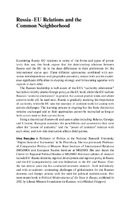Russia-EU relations and the common neighborhood
Proposal review
coercion vs. authority
| dc.contributor.author | Busygina, Irina | |
| dc.date.accessioned | 2020-02-05 11:36:29 | |
| dc.date.accessioned | 2020-04-01T08:52:55Z | |
| dc.date.available | 2020-04-01T08:52:55Z | |
| dc.date.issued | 2017 | |
| dc.identifier | 1007343 | |
| dc.identifier | 1007343 | |
| dc.identifier | OCN: 993977320 | |
| dc.identifier.uri | http://library.oapen.org/handle/20.500.12657/22819 | |
| dc.description.abstract | Examining Russia–EU relations in terms of the forms and types of power tools they use, this book argues that the deteriorating relations between Russia and the EU lie in the deep differences in their preferences for the international status quo. These different approaches, combined with economic interdependence and geographic proximity, means both parties experience significant difficulties in shaping strategy and formulating agendas with regards to each other. The Russian leadership is well aware of the EU’s "authority orientation" but fails to reliably predict foreign policy at the EU level, whilst the EU realizes Russia’s "coercive orientation" in general, but cannot predict when and where coercive tools will be used next. Russia is gradually realizing the importance of authority, while the EU sees the necessity of coercion tools for coping with certain challenges. The learning process is ongoing but the basic distinction remains unchanged and so their approaches cannot be reconciled as long as both actors exist in their current form. Using a theoretical framework and case studies including Belarus, Georgia and Ukraine, Busygina examines the possibilities and constraints that arise when the "power of authority" and the "power of coercion" interact with each other, and how this interaction affects third parties. | |
| dc.language | English | |
| dc.subject.classification | thema EDItEUR::J Society and Social Sciences::JP Politics and government | en_US |
| dc.subject.other | EU relations | |
| dc.title | Russia-EU relations and the common neighborhood | |
| dc.title.alternative | coercion vs. authority | |
| dc.type | book | |
| oapen.identifier.doi | 10.4324/9781315443966 | |
| oapen.relation.isPublishedBy | 7b3c7b10-5b1e-40b3-860e-c6dd5197f0bb | |
| oapen.relation.isbn | 9781315443959 | |
| oapen.relation.isbn | 9781138215467 | |
| oapen.relation.isbn | 9781032096612 | |
| oapen.relation.isbn | 9781315443966 | |
| oapen.pages | 250 | |
| oapen.remark.public | 21-7-2020 - No DOI registered in CrossRef for ISBN 9781138215467 | |
| oapen.remark.public | Funder name: University of Helsinki | |
| peerreview.anonymity | Single-anonymised | |
| peerreview.id | bc80075c-96cc-4740-a9f3-a234bc2598f1 | |
| peerreview.open.review | No | |
| peerreview.publish.responsibility | Publisher | |
| peerreview.review.stage | Pre-publication | |
| peerreview.review.type | Proposal | |
| peerreview.reviewer.type | Internal editor | |
| peerreview.reviewer.type | External peer reviewer | |
| peerreview.title | Proposal review | |
| oapen.review.comments | Taylor & Francis open access titles are reviewed as a minimum at proposal stage by at least two external peer reviewers and an internal editor (additional reviews may be sought and additional content reviewed as required). |

